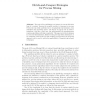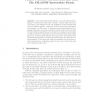99 search results - page 6 / 20 » Complete Process Semantics of Petri Nets |
APN
2006
Springer
13 years 11 months ago
2006
Springer
We consider nested nets, i.e. Petri nets in which tokens can be Petri nets themselves. We study value semantics of nested nets rather than reference semantics, and apply nested ne...
BPM
2009
Springer
14 years 2 months ago
2009
Springer
The goal of Process Mining is to extract process models from logs of a system. Among the possible models to represent a process, Petri nets is an ideal candidate due to its graphic...
IFM
2009
Springer
14 years 2 months ago
2009
Springer
Abstract. To model real-life critical systems, one needs“high-level”languages to express three important concepts: complex data structures, concurrency, and real-time. So far, ...
ENTCS
2007
13 years 7 months ago
2007
A category of event structures with symmetry is introduced and its categorical properties investigated. Applications to the event-structure semantics of higher order processes, no...
TOPNOC
2008
13 years 7 months ago
2008
Message Sequence Charts (MSCs) are a well known language for specifying scenarios that describe how different actors (e.g., system components, people, or organizations) interact. M...


